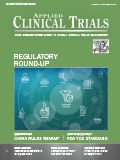Beyond Hard Outcomes: The Next Era in Heart Failure R&D
Applied Clinical Trials
Why and how FDA is funding a digital biomarkers study that centers on quality of life for patients with heart failure.

In June, FDA issued a relatively brief draft guidance1 that may reshape the foundation of drug research and development. In the guidance, FDA urged drugmakers to look beyond gold-standard outcomes such as mortality and hospitalizations in researching and developing new heart failure (HF) medications.
The agency stated that novel endpoints-such as functional capacity, symptom reduction, and quality of life-would also be acceptable criteria for new medication approvals, even without discernible effects on traditional hard outcomes such as hospitalizations and mortality.
Although FDA had been informally leaning in this direction for years, the formal statement was long overdue. Patient adherence to HF drug therapies is notoriously poor, hovering around 50%2, and generally worse when side effects appear, or symptoms fail to adequately subside. Yet HF carries an enormous health and economic burden. It’s the top global cause of hospitalizations for patients older than 65 years and costs $108 billion a year to manage worldwide.3
About 85% of hospitalized patients suffer from an acute HF event at least once, and 43% of patients are admitted to the hospital at least four times. Recent data from the CHAMP-HF registry demonstrates that fewer than one in four patients with heart failure with reduced ejection fraction (HFrEF) are on guideline directed medication therapy (GDMT), and only 1% are receiving target doses of medications.
Currently, no therapies have yet been shown to decrease mortality and hospitalization risk in patients with HFrEF. Although these patients experience a significant drop in functional capacity and quality of life, those outcomes have not yet been incorporated as endpoints within a regulatory pathway for drug approvals, mostly due to a lack of consensus around which improvements would be clinically meaningful.
Technology improving research pace, cost
To help move closer to a consensus on measuring quality of life in patients with HF, a new, FDA grant-funded collaborative research project is under way by the Yale University-Mayo Clinic Center of Excellence in Regulatory Science and Innovation (CERSI) and Biofourmis. The study leverages Biofourmis’ digital therapeutics platform for data collection and analysis. The goal of the research is to demonstrate the feasibility and reliability of identifying patient-centric endpoints based on monitoring data from 150 recently discharged patients with HF over a 60-day period, and aligning those with traditional outcomes.
Historically, such monitoring was a costly or time-consuming process. For example, although functional status can be objectively measured by peak exercise oxygen consumption (Vo2), it is difficult and impractical to implement in large clinical studies, especially in an ambulatory real-world setting. Patient-reported outcomes (PROs) are useful to record and quantify symptoms, but are also cumbersome and impractical, since significant resources are required to contact patients and administer questionnaires.
It is also particularly difficult to record patient-reported data and correlate it with physiologic signals; and using traditional methods, this cannot be done in real time.
Fortunately, technological advances in wearable biosensors, remote patient monitoring, predictive analytics, and consumer-facing apps have now enabled investigators to efficiently capture and analyze both physiologic biomarkers and PROs, and find associations between the two-in a fraction of the time and cost of traditional clinical trials. From participants’ homes, these technologies can capture and integrate data from disparate sources reflecting functional status, symptomatology, and perceived quality of life, potentially serving as surrogate endpoints for the approval of new HF therapeutic treatments.
Accelerating research through mobile
The CERSI study relies heavily on these advanced technologies to remotely deliver continuous, near real-time information. To capture the multiple physiology biomarkers and physical activity, patients wear two biosensors: a medical-grade device called Everion worn on the arm, and the consumer smartwatch Apple Watch Series 4. Together, the sensors monitor participants’ electrocardiogram, heart rate, respiration rate, activity intensity, 3-axis accelerometer, and sleep.
Data is collected through the Biofourmis BiovitalsHF platform, which is sensor-agnostic and uses advanced machine learning to derive dozens of physiology biomarkers. Using the Biofourmis Biovitals Analytics Engine, investigators can identify decompensation by detecting subtle physiologic changes from a participant’s personalized baseline-which means interventions can occur two to three weeks earlier than they would have otherwise, potentially preventing a major medical crisis. These predictive analytics also compute additional key matrices/derivatives, such as activity classification, posture, sleep analysis, heart rate variability analysis, and others.
At their homes, patients use the BiovitalsHF patient-facing companion app for syncing physiology data from sensors, responding to quality-of-life questionnaires, and recording their electronic patient-reported outcomes (ePROs).
The CERSI study participants were recruited from two hospitals by their physicians, who asked if they were interested in participating in research to monitor their physiology, functional capacity, and quality of life. Participants had all been hospitalized with a primary or secondary diagnosis of acute decompensated HF, which included at least one of the following symptoms: shortness of breath, orthopnea, or edema. They were assured that enrollment would not impact their care nor take away from the standard post-discharge follow-up visits.
Participants were then contacted by a research assistant (RA), who discussed the specifics of the study, obtained a signed consent and authorization form, and then helped participants create and activate a personalized account that would be accessed through their smartphone. The RA also trained participants to use and connect their wearable biosensors to the Biovitals smartphone app, how to use the app, fill out questionnaires, and perform the six-minute walk test, which is one of the tools used in the study to measure functional status. Vo2 tests were also performed, but only during monthly scheduled clinic visits.
Collected ePROs include information about HF symptoms and validated quality-of-life scales such as the Kansas City Cardiomyopathy Questionnaire, Profile of Mood States, and general questions about the participants’ well-being. HF medication adherence data also are collected using the smartphone app and reviewed by an RA who contacts participants with low adherence rates. The app plays a role in adherence by reminding participants to complete their ePROs and to sync their biosensors with the app. In addition, the study design includes monthly phone contact with all participants to document their healthcare service utilization, as well as a short close-out questionnaire at the conclusion of their monitoring.
A new direction for clinical trials
As of this writing, the CERSI/Biofourmis study results are currently under review, so results cannot yet be divulged. The research team has been very encouraged by the preliminary data, especially regarding the efficiency of the mobile health technology in collecting and analyzing data.
The CERSI/Biofourmis study marks the start of great potential for clinicians and pharmaceutical companies to change the way the effectiveness of certain drugs is evaluated-and not just for HF patients, but for many other conditions in which quality of life is important, such as pain, oncology, and chronic obstructive pulmonary disease (COPD). As FDA points out in its draft guidance: “The type of evidence of effectiveness needed to support the approval of drugs to treat heart failure does not differ from the evidence needed to support the approval of drugs intended to treat other conditions: substantial evidence demonstrating that the drug improves how a patient feels, functions (i.e., symptomatic or functional improvement), or survives.”4
As evidenced by this study and other research that is occurring across the world, we have entered into a new era in clinical trial design that encourages patient engagement and values quality of life-not just hard outcomes such as hospitalization and mortality. By leveraging wearables with high patient adherence rates, predictive analytics, and engaging patient-facing technology, researching and improving patient-centric outcomes is now significantly more feasible for investigators-and more satisfying for participants.
This CERSI/Biofourmis research has the potential to advance regulatory science and inform how novel digital therapeutics may be leveraged in the future to evaluate patient-centric outcomes that could serve as the basis for approval for therapies treating HF and other conditions. In addition, because these endpoints can be identified more quickly than hard outcomes, this approach could potentially decrease drug approval times for certain drugs-by as much as one to two years. These potentially shorter approval times could not only bring much-needed drugs to market more quickly, it would also decrease R&D costs.
References
- The U.S. Food and Drug Administration. “Treatment for Heart Failure: Endpoints for Drug Development, Guidance for Industry.” https://www.fda.gov/regulatory-information/search-fda-guidance-documents/treatment-heart-failure-endpoints-drug-development-guidance-industry. Draft Guidance. June 2019.
- Oosterom-Calo R, van Ballegooijen AJ, Terwee CB, et al. Determinants of adherence to heart failure medication: a systematic literature review. Heart Fail Rev. 2013;18(4):409–427.
- Greene, SJ, et al. “Medical Therapy for Heart Failure With Reduced Ejection Fraction: The CHAMP-HF Registry,” Journal of the American College of Cardiology. 2018;72(4):351-366, https://doi.org/10.1016/j.jacc.2018.04.070.
- U.S. FDA, et al.
Kuldeep Singh Rajput is the Founder and CEO of Biofourmis

Behind the Buzz: Why Clinical Research Leaders Flock to SCOPE Summit
February 7th 2025In this episode, we meet with Micah Lieberman, Executive Conference Director for SCOPE Summit (Summit for Clinical Ops Executives) at Cambridge Innovation Institute. We will dive deep into the critical role of collaboration within the clinical research ecosystem. How do we bring together diverse stakeholders—sponsors, CROs, clinical trial tech innovators, suppliers, patients, sites, advocacy organizations, investors, and non-profits—to share best practices in trial design, program planning, innovation, and clinical operations? We’ll explore why it’s vital for thought leaders to step beyond their own organizations and learn from others, exchanging ideas that drive advancements in clinical research. Additionally, we’ll discuss the pivotal role of scientific conferences like SCOPE Summit in fostering these essential connections and collaborations, helping shape the future of clinical trials. Join us as we uncover how collective wisdom and cross-industry partnerships are transforming the landscape of clinical research.
Reaching Diverse Patient Populations With Personalized Treatment Methods
January 20th 2025Daejin Abidoye, head of solid tumors, oncology development, AbbVie, discusses a number of topics around diversity in clinical research including industry’s greatest challenges in reaching diverse patient populations, personalized treatment methods, recruitment strategies, and more.
Phase III Trial Data Show Subcutaneous Pembrolizumab as Noninferior to IV Keytruda
March 31st 2025Subcutaneous administration of pembrolizumab with chemotherapy demonstrated a nearly 50% reduction in patient chair and treatment room time while maintaining efficacy and safety endpoints compared to intravenous Keytruda.
Phase II ALPACA Trial Shows Lepodisiran Produces Significant, Sustained Lipoprotein(a) Reductions
March 31st 2025Eli Lilly’s lepodisiran, an investigational siRNA therapy, achieved significant and durable reductions in lipoprotein(a) levels, a major genetic risk factor for cardiovascular disease.